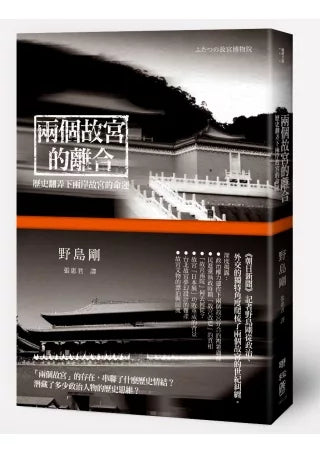1
/
of
1
The separation of the two Forbidden Cities
The separation of the two Forbidden Cities
Nojima Tsuyoshi Zhang Huijun 译
Regular price
$20.99 USD
Regular price
Sale price
$20.99 USD
Unit price
/
per
Low stock
Couldn't load pickup availability
About Book
About Book
ふたつのNational Palace Museum
The "Two Forbidden Cities" are a product of East Asia's modern history.The charm of the Forbidden City stems from its many miraculous historical twists and turns.
The National Palace Museums on both sides of the Taiwan Strait are not only treasure houses of rare and magnificent things,
It also reveals the deep structures of political power and culture.
What historical complexes are connected by the existence of the "two Forbidden Cities"? How much historical thinking do these hidden politicians possess?
In "The Separation of Two Forbidden Cities: The Fate of the National Palace Museums on Both Sides of the Taiwan Strait Under the Twist of History," Tsuyoshi Nojima, a reporter for the Asahi Shimbun and an expert on China, explores the centuries-long entanglement between the two Forbidden Cities from a unique political and diplomatic perspective.
The best storyteller in the media takes you to witness the history of the two Forbidden Cities. This book reveals in depth:
The complex process of separating and uniting the two National Palace Museums under the manipulation of political power. The truth behind the "National Palace Museum renovation" during the Democratic Progressive Party's administration. What will become of the "National Palace Museum Southern Branch"?
The background to the National Palace Museum's failed "Japan Exhibition." The difficult birth of the Taipei National Palace Museum's dreamy design. The wandering and returning of National Palace Museum artifacts. The two National Palace Museums, rather than being twins with similar appearances, are more like a divided map.
"The Separation of Two Forbidden Cities: The Fate of the National Palace Museums on Both Sides of the Taiwan Strait Under the Twist of History" takes you to witness the survival history of the two Forbidden Cities and piece together the future of the Chinese world.
The author, Tsuyoshi Nojima, is a rare Japanese figure with a profound understanding of the politics, diplomacy, and culture of the Chinese communities across Taiwan, Mainland China, and Hong Kong. He possesses not only a professional journalistic background but also a gifted storyteller. In "The Separation of the Two Forbidden Cities," he interprets and explains the deep-seated political power and cultural structures behind the "Two Forbidden Cities," a product of modern East Asian history, from the perspective of an objective third-party journalist, or perhaps even one with a "for the good of the Taiwanese people" perspective.
Simply put, the "two Forbidden City" was born out of the "two Chinas".
Nojima Tsuyoshi traveled from north to south, visiting Shenyang, Beijing, Kyoto, Nanjing, Shanghai, Chongqing, Taipei, Hong Kong, Singapore, etc., collecting testimonies from people who participated in important changes in the National Palace Museum and were considered the Palace Museum's living dictionary treasures, such as "Na Zhiliang". He also interviewed former directors of the National Palace Museum in Taipei: Tu Cheng-sheng, Lin Man-li, and the current director Zhou Gong-xin. He consulted Chiang Kai-shek's diaries stored at the Hoover Institution at Stanford University in the United States, and compiled first-hand interview materials on National Palace Museum studies. After the Japanese version was published, he followed the ever-changing political situation and revised and supplemented it repeatedly before the traditional Chinese version was published. He also wrote a postscript specifically for Taiwanese readers, tracking the latest developments of the National Palace Museum's "Japan Exhibition".
Nojima's primary purpose in writing this book is not to discuss the artistic value of the National Palace Museum, nor does he delve into the superiority of its collection. The history of the National Palace Museum, from its founding in 1925 to its split in 1949, is well documented in oral histories and historical works in China, Taiwan, and Japan. However, systematic coverage of the reopening of the National Palace Museum in Taipei in Taiwan in 1965, the Democratic Progressive Party's attempts to reform the museum, China's recent surge in the search for and recovery of cultural relics, and the close exchanges between the National Palace Museum and Taiwan since the KMT's return to power in 2008 remain virtually unexplored, not only in Japan but also in Taiwan. These are the key areas of focus in this book.
"The Separation of the Two Forbidden Cities" is divided into eight chapters. Chapter 1 introduces the "Forbidden City Renovation" plan proposed by the Democratic Progressive Party after it came to power in 2000. Chapter 2 discusses the outflow of Forbidden City artifacts before and after the Xinhai Revolution. Chapter 3 explains the process of transporting Forbidden City artifacts to the south and west during the Japanese invasion of China. Chapter 4 discusses the transfer of Forbidden City artifacts to Taiwan around 1949, examining the policy decision-making process. Chapter 5 explains the construction of the Taipei National Palace Museum after the division of Taiwan and the birth of the two Forbidden Cities. Chapter 6 attempts to analyze the phenomenon of Forbidden City artifacts scattered around the world "returning" to China. Chapter 7 predicts the future of the "two Forbidden Cities."
Publication Date
Publication Date
2012-07-01
Publisher
Publisher
聯經出版事业公司
Imprint
Imprint
Pages
Pages
280
ISBN
ISBN
9789570840179
share

